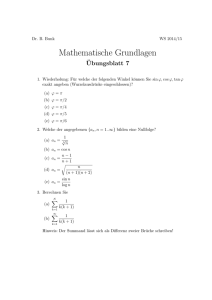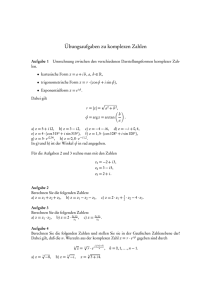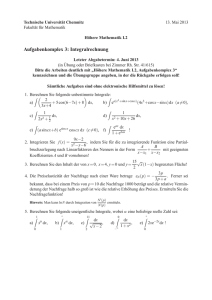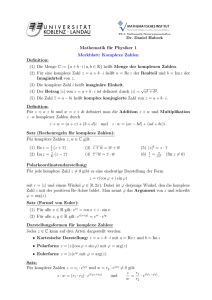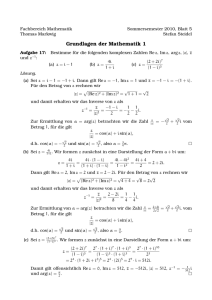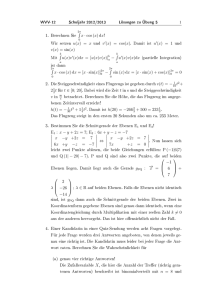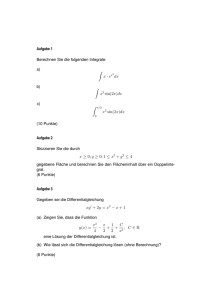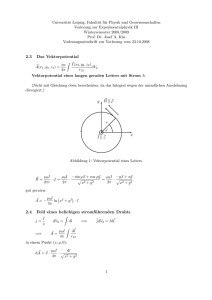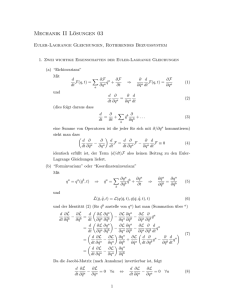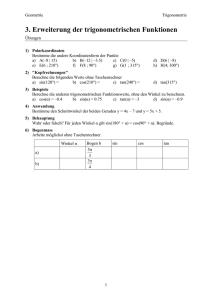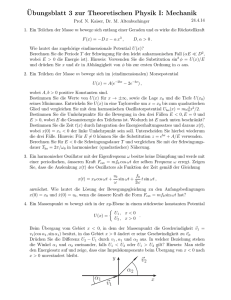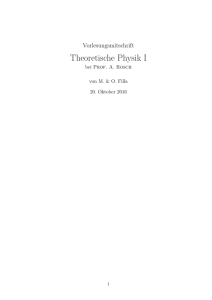Höhere Mathematik I für BWIW, BNC, BAI, BGIP, GTB, Ma
Werbung
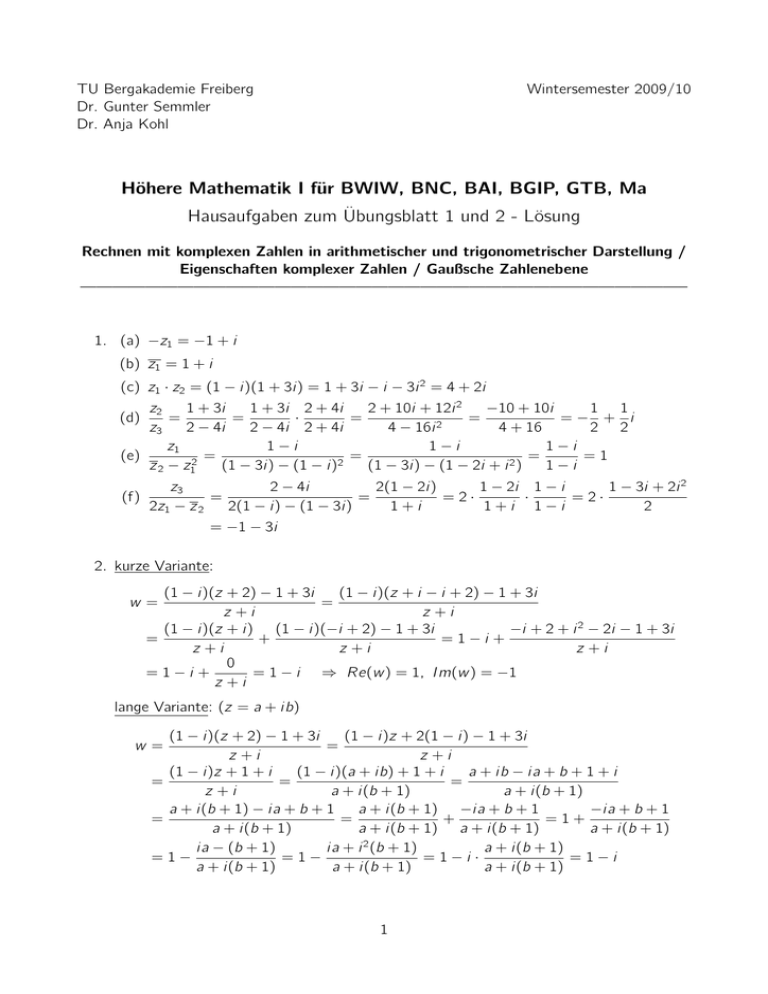
TU Bergakademie Freiberg
Dr. Gunter Semmler
Dr. Anja Kohl
Wintersemester 2009/10
Höhere Mathematik I für BWIW, BNC, BAI, BGIP, GTB, Ma
Hausaufgaben zum Übungsblatt 1 und 2 - Lösung
Rechnen mit komplexen Zahlen in arithmetischer und trigonometrischer Darstellung /
Eigenschaften komplexer Zahlen / Gaußsche Zahlenebene
—————————————————————————————————————–
1. (a) −z1 = −1 + i
(b) z1 = 1 + i
(c) z1 · z2 = (1 − i )(1 + 3i ) = 1 + 3i − i − 3i 2 = 4 + 2i
z2
1 + 3i 2 + 4i
2 + 10i + 12i 2
1 1
1 + 3i
−10 + 10i
=
·
=
=− + i
=
=
2
z3
2 − 4i
2 − 4i 2 + 4i
4 − 16i
4 + 16
2 2
1−i
z1
1−i
1−i
(e)
=
=
=1
2 =
2
2
z 2 − z1
(1 − 3i) − (1 − i)
(1 − 3i ) − (1 − 2i + i )
1−i
(d)
(f)
z3
2 − 4i
2(1 − 2i )
1 − 2i 1 − i
1 − 3i + 2i 2
=
=
=2·
·
=2·
2z1 − z 2
2(1 − i ) − (1 − 3i)
1+i
1+i 1−i
2
= −1 − 3i
2. kurze Variante:
(1 − i )(z + 2) − 1 + 3i
(1 − i )(z + i − i + 2) − 1 + 3i
=
z +i
z +i
(1 − i )(z + i ) (1 − i )(−i + 2) − 1 + 3i
−i + 2 + i 2 − 2i − 1 + 3i
=
+
=1−i +
z +i
z +i
z +i
0
=1−i +
= 1 − i ⇒ Re(w ) = 1, Im(w ) = −1
z +i
w=
lange Variante: (z = a + ib)
(1 − i )(z + 2) − 1 + 3i
(1 − i )z + 2(1 − i ) − 1 + 3i
=
z +i
z +i
(1 − i )z + 1 + i
(1 − i )(a + i b) + 1 + i
a + ib − ia + b + 1 + i
=
=
=
z +i
a + i (b + 1)
a + i (b + 1)
a + i (b + 1) − ia + b + 1
a + i (b + 1) −i a + b + 1
−i a + b + 1
=
=
+
=1+
a + i (b + 1)
a + i (b + 1) a + i (b + 1)
a + i (b + 1)
2
i a − (b + 1)
i a + i (b + 1)
a + i (b + 1)
=1−
=1−
=1−i ·
=1−i
a + i(b + 1)
a + i (b + 1)
a + i (b + 1)
w=
1
ganz lange Variante: mit dem Reziproken des Nenners multiplizieren
3. |z1 | =
√
1 + 3 = 2, ar g(z1 ) = arctan
q
|z2 | =
1
4
+ 34 = 1,
cos 32 π + i
ar g(z2 ) = arctan
√
3
1
√
3
2
− 12
=
π
3
¡
¢
→ z1 = 2 cos π3 + i sin π3
√
+ π = arctan(− 3) + π =
2π
3
sin 23 π
→ z2 =
√
√
π
5π
|z3 | = 9 + 9 = 3 2, ar g(z3 ) = arctan −3
−3 + π = 4 + π = 4
¢
√ ¡
→ z3 = 3 2 cos 54 π + i sin 54 π
¢
√
√ ¡
7
π
7π
7
|z4 | = 2, ar g(z4 ) = arctan −1
2
cos
=
−
=
→
z
=
π
+
i
sin
π
4
1
4
4
4
4
µ
µ
¶
µ
¶¶
π 2
π 2
(a) z1 · z2 = 2 · 1 cos
+ π + i sin
+ π
= 2 (cos π + i sin π) = −2
3 3
3 3
(b) Trigonometrische Form von z 2 :
¡
¢
¡
¢
z 2 = cos 23 π − i sin 23 π = cos − 23 π + i sin − 23 π
(∗)
¡
¢
¡
¢
¡
¢
¡ ¢
= cos 2π − 32 π + i sin 2π − 23 π = cos 34 π + i sin 34 π
µ
µ
¶
µ ¶¶
³
³
³
π ´´
π 4
5
π´
+ i sin 2π −
z1 ·z 2 = 2·1 cos
+ π + i sin
π
= 2 cos 2π −
3
³
³ π ´ 3 ³3 π ´´
³ 3 ³π ´
³ π ´´ 3
√
= 2 cos −
+ i sin −
= 2 cos
− i sin
= 1 − 3i
3
3
3
3
Hinweis: (∗) ist noch nicht die trigonometrische Form vom z 2 , weil das Argument
− 23 π nicht aus dem Intervall [0; 2π) ist ! Wegen der Periodizität der Winkelfunktionen kann man für die praktische Rechnung aber auch diese Form benutzen und
erhält dann kürzer:
µ
µ
µ
¶¶
³ π ´¶
√
π
2
z1 · z 2 = 2 · 1 cos
+ − π
+ i sin −
= 1 − 3i .
3
3
3
µ
µ
¶
µ
¶¶
³
³
³
√ 2
7
14
π´
π ´´
2
(c) z4 = ( 2) cos 2 · π + i sin
π
= 2 cos 2π −
+ i sin 2π −
4³
4
2
2
´´
³
´
³
³ π´
π
π
π
= 2 cos −
+ i sin −
= 2 cos − i sin
= −2 i
2
2
2
2
µ
µ
¶
µ
¶¶
³
³ π´
³ π ´´
2
z1
π 2
π 2
=
(d)
cos
− π + i sin
− π
= 2 cos −
+ i sin −
=
z2³
3 ³ 3´´
3 3
3
3
³1 π ´
√
π
− i sin
= 1 − 3i
2 cos
3
3
z1
= z1 · z 2 .)
(wegen z2 · z 2 = 1 ergibt sich hier
z2
µ
µ
¶
µ
¶¶
22
z12
π
2
7
π
2
7
√
=
(e) 3
cos 2 · − 3 · π − π + i sin 2 · − 3 · π − π
=
z2 · z4 µ 13 ·µ 2
3
3
4
3
3
4
¶
µ
¶¶
22
37
37
√
cos − π + i sin − π
= −2, 73 + 0, 73 i
12
12
13 · 2
2
µ
¶
µ
¶¶
7
49
π
(f)
= ( 2) cos 7 · π + i sin
4´
4
³
³
³
√
√ ³
π
π
π´
π ´´
= 8 2 cos 12π +
+ i sin 12π +
= 8 2 cos + i sin
= 8 + 8i
4
4
4
4
z47
√
µ
7
4. Seien z1 = a1 + i b1 , z2 = a2 + ib2 .
(a)
z1 − z2 = (a1 + ib1 ) − (a2 + ib2 ) = (a1 − a2 ) + i (b1 − b2 )
= (a1 − a2 ) − i (b1 − b2 ) = (a1 − i b1 ) − (a2 − i b2 ) = z1 − z2
(b)
z1
a1 + ib1
a1 + ib1 a2 − i b2
a1 a2 + b1 b2 + i(−a1 b2 + a2 b1 )
=
=
·
=
z2
a2 + ib2
a2 + ib2 a2 − i b2
a22 + b22
−a1 b2 + a2 b1
a1 a2 + b1 b2
−a1 b2 + a2 b1
a1 a2 + b1 b2
+i ·
=
−i ·
=
2
2
2
2
2
2
a2 + b2
a2 + b2
a2 + b2
a22 + b22
a1 a2 + b1 b2 + i (a1 b2 − a2 b1 )
=
a22 + b22
z1
a1 − i b 1
a1 − ib1 a2 + i b2
a1 a2 + b1 b2 + i (a1 b2 − a2 b1 )
=
=
·
=
z2
a2 − i b 2
a2 − ib2 a2 + i b2
a22 + b22
Vergleich der beiden Seiten zeigt Gleichheit.
5. Sei z = a + ib.
(a) geometrische Lösung:
µ
¶
1 1
2z − 1 + i = 2 z − + i
2 2
|
{z
}
=z 0
|
{z
}
→ |2z − 1 + i | = |z 00 |
=z 00
|z 00 | ≤ 3 → Die Lösungsmenge für z 00 ist das Innere des Kreises (inklusive des
Randes) mit Radius 3 und Mittelpunkt (0, 0) = 0 + 0i = 0.
00
z 0 = z2 → Die Lösungsmenge für z 0 erhält man durch Stauchen der Lösungsmenge
für z 00 , indem der Radius des Kreises halbiert wird. Folglich ist die Lösungsmenge
für z 0 das Innere des Kreises (inklusive des Randes) mit Radius 32 und Mittelpunkt
(0, 0) = 0 + 0i = 0.
z = z 0 + 21 − 12 i → Die Lösungsmenge für z erhält man durch Verschieben der
Lösungsmenge von z 0 um 21 nach rechts (Realteil + 12 ) und 12 nach unten (Imaginärteil
− 12 ). Folglich ist die Lösungsmenge für z ist das Innere des Kreises (inklusive des
Randes) mit Radius 23 und Mittelpunkt ( 12 , − 21 ) = 12 − 12 i .
3
rechnerische Lösung:
|2z − 1 + i | = |2(a + ib) − 1 + i | = |(2a − 1) + i (2b + 1)| =
|2z − 1 + i|
p
(2a − 1)2 + (2b + 1)2
(2a − 1)2 + (2b + 1)2
¡
¢2
¡
¢2
4 a − 21 + 4 b + 12
¡
¢2 ¡
¢2
a − 21 + b + 12
¡
¢2 ¡
¢2
Re(z) − 12 + Im(z) + 21
⇐⇒
=⇒
⇐⇒
⇐⇒
⇐⇒
p
≤
≤
≤
≤
≤
≤
(2a − 1)2 + (2b + 1)2
3
3
9
9
9
¡4 3 ¢2
2
Im x − y −Koordinatensystem hat ein Kreis mit Radius r und Mittelpunkt (s, t) die
allgemeine Kreisgleichung (x − s)2 + (y − t)2 = r 2 . Folglich hat in der Gaußschen
Zahlenebene ein Kreis mit Radius r und Mittelpunkt (s, t) (d.h. der Mittelpunkt liegt
bei der komplexen Zahl s + it) die Kreisgleichung (Re(z) − s)2 + (Im(z) − t)2 = r 2 .
Daraus erkennt man, dass die Lösungsmenge
¡
¢ obiger Ungleichung die Fläche des
Kreises mit Radius 23 und Mittelpunkt 12 , − 12 , also der komplexen Zahl 12 − 12 i ist.
(b) (I)
(II)
p
|z − 1 − i | = |a + ib − 1 − i | = |(a − 1) + i (b − 1)| = (a − 1)2 + (b − 1)2
p
|z + 1| = |a + ib + 1| = |(a + 1) + i b| = (a + 1)2 + b2
(I)=(II):
p
=⇒
⇐⇒
⇐⇒
⇐⇒
(a − 1)2 + (b − 1)2
(a − 1)2 + (b − 1)2
a2 − 2a + 1 + b2 − 2b + 1
b
Im(z)
p
=
(a + 1)2 + b2
= (a + 1)2 + b2
= a2 + 2a + 1 + b2
= 12 − 2a
= 12 − 2Re(z)
→ Lösungsmenge ist eine Gerade mit Anstieg −2
und Schnittpunkt mit der imaginären Achse bei
(a)
Im 6
1
2
(b)
Im 6
2
1
1
−1
−1
1
2
-
Re
−1
−1
−2
−2
4
1
2
Re
(c) Es muss z 6= 0 gelten, da sonst durch 0 geteilt wird.
⇐⇒
⇐⇒
⇐⇒
⇐⇒
⇐⇒
⇐⇒
⇐⇒
1
z
+ z1 = 1 (z 6= 0)
z +z =z ·z
(a − ib) + (a + ib)
2a
0
1
1
1
=
=
=
=
=
=
(a + i b)(a − i b)
a2 + b 2
a2 − 2a + b2
(a2 − 2a + 1) + b2
(a − 1)2 + b2
(Re(z) − 1)2 + Im2 (z)
→ Lösungsmenge ist ein Kreis mit Radius 1
und Mittelpunkt bei (1, 0), also der komplexen Zahl 1 + 0i = 1, aber ohne die 0
(d) (I)
(II)
p
(a − 3)2 + b2
p
2|z + 3| = 2|a + ib + 3| = 2|(a + 3) + i b| = 2 (a + 3)2 + b2
|z − 3| = |a + ib − 3| = |(a − 3) + ib| =
(I)=(II):
p
(a − 3)2 + b2
(a − 3)2 + b2
a2 − 6a + 9 + b2
0
0
25
16
42
=⇒
⇐⇒
⇐⇒
⇐⇒
⇐⇒
⇐⇒
⇐⇒
=
=
=
=
=
=
=
=
p
2 (a + 3)2 + b2
4((a + 3)2 + b2 )
4a2 + 24a + 36 + 4b2
3(a2 + 10a + b2 + 9)
a2 + 10a + b2 + 9
(a2 + 10a + 25) + b2 + 9
(a + 5)2 + b2
(Re(z) + 5)2 + Im2 (z)
→ Lösungsmenge ist ein Kreis mit Radius 4
und Mittelpunkt bei (−5, 0), also der komplexen Zahl −5 + 0i = −5
(c)
Im 6
(d)
1
Im 6
4
2
−1
−1
1
2
-
Re
−10 −8 −6 −4 −2
−2
−2
−4
5
2
Re
6. z = cos x + i sin x
Für die dritte Potenz z 3 gilt:
(I)
z 3 = (cos x + i sin x)3 = cos(3x) + i sin(3x)
(Formel von Moivre)
(II)
z 3 = (cos x + i sin x)3 = cos3 x + 3i cos2 x sin x + 3i 2 cos x sin2 x + i 3 sin3 x
(Binomialsatz oder einfach Ausmultiplizieren)
¡
¢
= (cos3 x − 3 cos x sin2 x) + i 3 cos2 x sin x − sin3 x
Gleichsetzen von (I) und (II) liefert:
¡
¢
cos(3x) + i sin(3x) = (cos3 x − 3 cos x sin2 x) + i 3 cos2 x sin x − sin3 x
Da zwei komplexe Zahlen gleich sind, genau dann, wenn die Real-und Imaginärteile gleich
sind, erhalten wir aus der einen Gleichung nun zwei Gleichungen:
Re:
Im:
cos(3x) = (cos3 x − 3 cos x sin2 x)
sin(3x) = 3 cos2 x sin x − sin3 x
Uns interessiert hier aber nur die Gleichung für den Imaginärteil, da dort sin(3x) aus der
Aufgabenstellung auftaucht. Es gilt:
sin(3x) = 3 cos2 x sin x − sin3 x = 3 cos2 x sin x − 4 sin3 x + 3 sin3 x
= 3 sin x (cos2 x + sin2 x) −4 sin3 x = 3 sin x − 4 sin3 x
|
{z
}
=1
7. Um die Formel von Moivre anwenden zu können, brauchen wir z0 in der trigonometrischen
Darstellung: z0 = r (cos ϕ + i sin ϕ)
Für z 0 ¡gilt dann z 0 = r (cos ϕ − i sin¢ϕ), denn:
¡
¢
¡
¢
z 0 = r cos(2π − ϕ) + i sin(2π − ϕ) = r cos(−ϕ) + i sin(−ϕ) = r cos(ϕ) − i sin(ϕ)
Da z0 Lösung der Gleichung an z n + an−1 z n−1 + . . . + a1 z + a0 =
0=
n
X
Pn
k=0
ak z k = 0 ist, gilt:
ak z0k
k=0
=
n
X
ak [r (cos ϕ + i sin ϕ)]k
k=0
=
n
X
ak r k [cos(kϕ) + i sin(kϕ)]
(Formel von Moivre)
k=0
Da die Koeffizienten ak alle reelle Zahlen sind (ebenso wie der Betrag r und die Sinusund Kosinusfunktionen), lässt sich die Summe nun in Real- und Imaginärteil aufteilen:
=
n
X
|k=0
k
ak r cos(kϕ) +i ·
{z
}
n
X
|k=0
Re=0
ak r k sin(kϕ)
{z
Im=0
6
}
Da die linke Seite der Gleichung 0 ist, muss es auch die rechte sein. Folglich muss Re = 0
und Im = 0 gelten. Wegen Im = 0 gilt natürlich auch −Im = 0, daher darf man das
Vorzeichen vor Im ändern, also die komplexe Zahl auf der rechten Seite konjugieren:
=
n
X
|k=0
ak r k cos(kϕ) −i ·
{z
}
n
X
|k=0
Re=0
=
n
X
ak r k sin(kϕ)
{z
}
Im=0
ak r k [cos(kϕ) − i sin(kϕ)]
k=0
=
n
X
ak [r (cos(ϕ) − i sin(ϕ))]k
k=0
=
n
X
ak z k0
k=0
Damit ist auch z 0 Lösung der Gleichung.
7
(Formel von Moivre)
